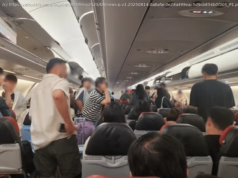«Giving support for infants and small children and pregnant women should be handled separately from politics.»
Last week, North Korea threatened to wipe out South Korea with a “ fire attack.” Today, Seoul announced it will be sending $8 million in humanitarian aid to North Korea.
South Korea’s Ministry of Unification, which has the express goal of one day reuniting the two Koreas, agreed to send the aid package to help children and pregnant women, according to Unification Minister Cho Myung-gyon. Around $4.5 million will go to the UN World Food Program to relieve malnutrition. Another $3.5 million will go to UNICEF, the multinational body’s children’s agency, for vaccinations and fend off disease. The BBC reports that about 28 percent of children in North Korea are malnourished.
So what’s the deal? Why is the South sending aid to a country that is threatening to obliterate it?
“In principle, giving support for infants and small children and pregnant women should be handled separately from politics,” Moon said on a call with Japanese Prime Minister Shinzo Abe. Abe had called to ask Moon to rethink sending the aid because it might lessen the pressure on Pyongyang to end its nuclear and ballistic missile programs. But Moon, who has long argued for more engagement with North Korea and is himself the son of North Korean refugees, clearly disagreed with Abe.
Moon’s decision comes just under two weeks after the UN passed its toughest sanctions on North Korea yet. Lee Eugene, a Unification Ministry spokesperson, told the New York Times those measures would harm poor North Koreans, including the elderly and new mothers. President Donald Trump told reporters today that America imminently plans to slap more sanctions on North Korea.
The Obama administration authorized $1 million in aid to North Korea the day before Donald Trump took office, the first time America had done so since 2011. It was sent after Typhoon Lionrock hit North Korea with massive rainfall, which led to widespread flooding. Between 1995 and 2008, the US provided around $1.3 billion in aid to North Korea, mostly giving food and energy help. South Korea’s aid will add to the American total, which experts say is desperately needed by North Koreans.
“Children who are suffering and dying in [North] Korea are not the people who should be paying the price for whatever else is going on,” Chris De Bono, UNICEF’s chief of communication for East Asia and Pacific, told the BBC. When asked if the recipients would know where the aid was coming from, he said, “probably not, but that doesn’t matter.”
“You’re talking about very poor children, many of whom are under 1, most of whom are under 5. So whether or not they know where it comes from, I don’t really care,” de Bono continued. “They can’t be allowed to suffer and die because of decisions taken by adults.”
North Korea suffered a great famine in the 1990s that starved around 23 million North Koreans and killed around 10 percent of the population.
The country remains a mostly agricultural society. The problem is that North Korea’s climate is tough for that kind of life: It’s a mountainous region with harsh winters — only about 20 percent of the land in North Korea is arable, according to the CIA. And in 1995, a big flood took out about 15 percent of North Korea’s arable land.
Since then, North Korea’s economy has improved, but it still relies on farming to feed its people. And Kim Jong Un’s regime cares more about its nuclear and missiles programs than it does its growing its economy and feeding its people.
That’s why South Korea’s aid is so important, even if it comes at an odd time.






